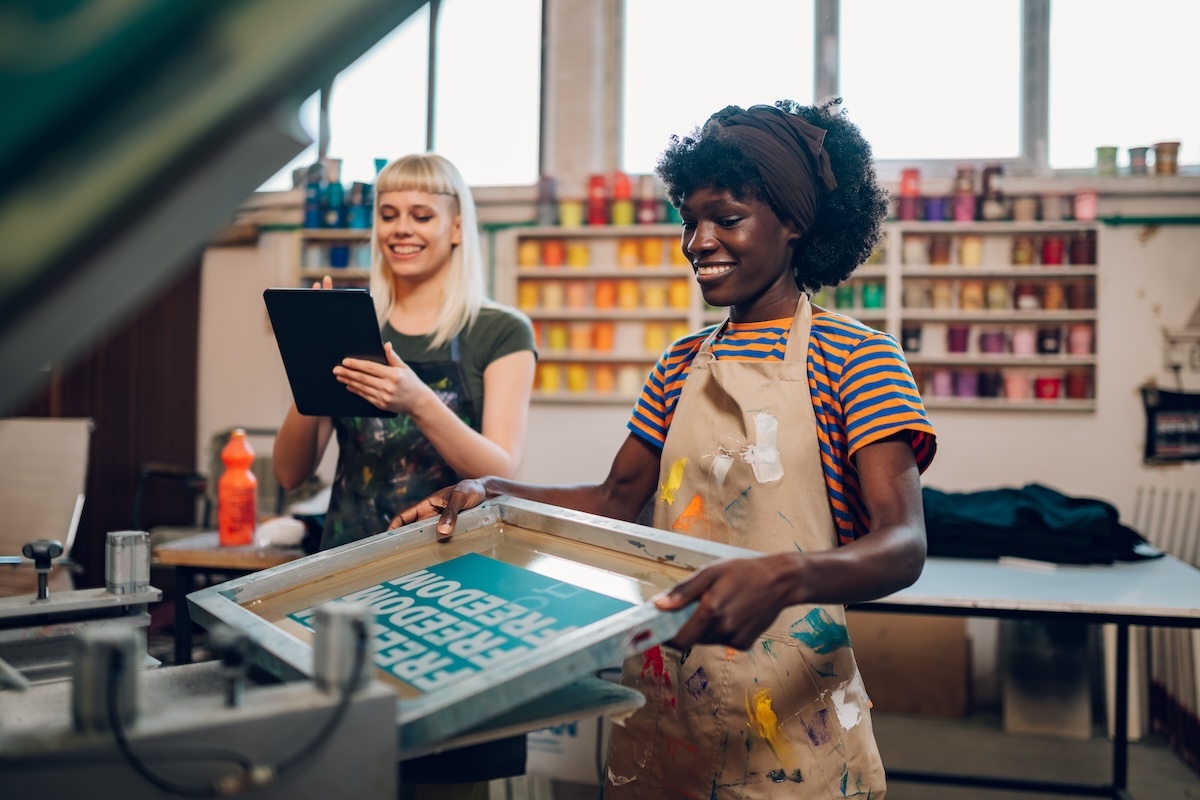So you're thinking about starting an online business but can't decide between print on demand vs dropshipping? I totally get it. When I first started my ecommerce journey, I was completely confused about these two business models. They sound similar, but they're actually quite different.
Let me break this down for you in simple terms. Both print on demand and dropshipping let you sell products without holding inventory, but that's where the similarities end. Understanding the differences between print on demand vs dropshipping could be the key to choosing the right path for your business.
I've tried both models over the years, and I've learned some valuable lessons along the way. Today, I'm going to share everything I know about print on demand vs dropshipping so you can make the best decision for your situation.
What Is Print on Demand?
Before we dive into print on demand vs dropshipping comparisons, let me explain what each model actually is. Think of print on demand (POD) as custom manufacturing on steroids.
With print on demand, you create designs for products like t-shirts, mugs, phone cases, or posters. When a customer orders one of your products, a printing company creates that specific item with your design and ships it directly to your customer.

Here's how print on demand works:
- You create or upload a design
- You apply that design to products in the POD platform
- You set your selling price
- A customer orders your product
- The POD company prints and ships the item
- You keep the profit margin
The beauty of print on demand is that every product is made specifically for each order. No inventory, no upfront costs for products, and no waste from unsold items.
Popular print on demand platforms include Printful, Printify, and Gooten. These companies handle all the printing and shipping while you focus on creating designs and marketing your products.
What Is Dropshipping?
Now let's talk about dropshipping in our print on demand vs dropshipping comparison. Dropshipping is when you sell existing products without holding any inventory yourself.
With dropshipping, you find products from suppliers (usually manufacturers or wholesalers), list them in your online store, and when customers buy them, your supplier ships the products directly to your customers.
Here's how dropshipping works:
- You find products from suppliers
- You list these products in your store
- You set your selling price
- A customer orders a product
- You forward the order to your supplier
- The supplier ships directly to your customer
- You keep the difference between what you charged and what you paid
The key difference in print on demand vs dropshipping is that dropshipping involves selling existing products, while print on demand involves creating custom products with your designs.
According to Shopify's research, dropshipping is expected to be worth $476.1 billion by 2026, showing just how popular this business model has become.
Print on Demand vs Dropshipping: 7 Key Differences
Now let's get into the meat of print on demand vs dropshipping by examining the key differences that matter most for your business decision.
1. Product Uniqueness and Customization
This is probably the biggest difference in the print on demand vs dropshipping debate. With print on demand, you're creating unique products that no one else has. Your designs are yours, and customers can't find the exact same product anywhere else.
I love this aspect of print on demand because it eliminates direct competition on price. When someone wants your specific design, they have to buy it from you.
With dropshipping, you're selling the same products that potentially thousands of other sellers are offering. This often leads to price wars and makes it harder to stand out from the competition.
However, dropshipping gives you access to a much wider variety of products. You can sell electronics, home goods, fitness equipment, beauty products – basically anything you can find from suppliers.
2. Startup Costs and Investment

When comparing print on demand vs dropshipping in terms of startup costs, print on demand usually requires less upfront investment. Most POD platforms are free to use, and you only pay when you make a sale.
The main investment in print on demand is time – specifically, time spent creating or sourcing designs. If you're not artistic, you might need to hire designers or buy designs, but these costs are typically much lower than other business investments.
Dropshipping can require more upfront investment, especially if you want to test products by ordering samples or if you choose to hold some inventory for faster shipping. You might also need to pay for product research tools or supplier memberships.
That said, both models are relatively low-cost compared to traditional retail businesses. You don't need to buy inventory upfront, rent warehouse space, or invest in manufacturing equipment.
If you're interested in skipping the building stage, check out our article on how to buy an established print-on-demand business.
3. Profit Margins and Pricing
Profit margins in print on demand vs dropshipping can vary significantly depending on your products and strategy. In my experience, print on demand often offers higher profit margins because you're selling unique products with less direct competition.
For example, you might sell a custom t-shirt for $25 while paying $8 to the print-on-demand company, giving you a 68% profit margin. These margins are possible because customers value unique designs and are willing to pay premium prices.
Dropshipping margins are typically lower due to competition. You might sell a phone case for $15 while paying $5 to your supplier, resulting in a 67% margin. However, fierce competition often forces prices down, reducing your actual margins.
According to Oberlo's dropshipping statistics, successful dropshippers typically achieve profit margins between 10-30%, while print on demand businesses often see margins of 20-50%.
4. Marketing and Branding Opportunities

The branding game is quite different when you're looking at print on demand vs dropshipping. Print on demand gives you incredible branding opportunities because you control the entire product design.
You can create cohesive product lines, develop signature styles, and build a brand around your designs. I've seen POD businesses become recognized brands in specific niches like fitness motivation or pet lovers.
With dropshipping, branding is more challenging because you're selling other people's products. You can brand your packaging and customer experience, but the products themselves usually carry the original manufacturer's branding.
However, dropshipping does offer more flexibility in terms of target markets. You can quickly pivot to different product categories or test various niches without being tied to specific design themes.
For insights on building a strong brand, check out our guide on how to grow your Instagram page, which covers branding strategies that apply to both business models.
5. Time Investment and Scalability
Time management differs significantly in print on demand vs dropshipping. Print on demand requires ongoing creative work to develop new designs and stay current with trends. You're essentially running a design business alongside your ecommerce store.
I spend about 20-30% of my time on design-related tasks when running POD businesses. This includes creating new designs, researching trends, and optimizing existing products.
Dropshipping typically requires more time upfront for product research and supplier relationships, but less ongoing creative work. Once you find winning products and reliable suppliers, the business can run more automatically.
In terms of scalability, both models can grow significantly, but they scale differently. Print on demand scales through design variety and marketing effectiveness, while dropshipping scales through product diversification and operational efficiency.
6. Quality Control and Customer Satisfaction
Quality control in print on demand vs dropshipping presents different challenges. With print on demand, quality depends entirely on your printing partner. Most established POD companies have good quality standards, but you have limited control over the final product.
I always order samples of my POD products before selling them to ensure quality meets my standards. This small investment can save you from customer complaints later.
Dropshipping quality control can be more complex because you're dealing with various suppliers who may have different quality standards. This is especially true when working with overseas suppliers.
Customer satisfaction also differs between these models. POD customers often have higher expectations because they're paying premium prices for custom products. They expect high-quality printing and materials.
Dropshipping customers might be more price-sensitive and less concerned about premium quality, but they often expect faster shipping times since they're buying existing products.
7. Shipping Times and Customer Expectations

Shipping is a crucial factor in the print on demand vs dropshipping comparison. Print on demand typically takes longer because each product must be printed before shipping. Most POD orders take 5-10 business days to fulfill.
This longer fulfillment time can be a disadvantage, especially for customers accustomed to Amazon's fast shipping. However, customers buying custom products often understand and accept longer wait times.
Dropshipping shipping times vary dramatically depending on your suppliers. Domestic suppliers might ship within 2-3 days, while international suppliers could take 2-4 weeks.
Fast shipping is crucial for customer satisfaction. According to BigCommerce research, 61% of consumers expect deliveries within 1-3 business days for online purchases.
To address shipping concerns in either model, consider our article on best wholesale Shopify apps, which covers tools that can help streamline your fulfillment process.
Print on Demand vs Dropshipping: Which Should You Choose?
After examining all these factors in our print on demand vs dropshipping analysis, you might wonder which model is right for you. The answer depends on your skills, interests, and business goals.
Choose Print on Demand if:
- You have design skills or enjoy creative work
- You want to build a unique brand
- You're comfortable with longer shipping times
- You prefer higher profit margins over volume sales
- You want less competition on specific products
Choose Dropshipping if:
- You prefer testing and marketing existing products
- You want access to a wide variety of products
- You can handle intense competition
- You're focused on scaling through volume
- You want faster shipping options
Many successful entrepreneurs actually use both models. You could start with one and add the other later, or run separate stores for each model.
How DropCommerce Fits Into Your Business Strategy
If you're leaning toward dropshipping in our print on demand vs dropshipping comparison, DropCommerce offers significant advantages over traditional dropshipping platforms.
DropCommerce focuses on North American suppliers, which means faster shipping times and better customer service compared to overseas suppliers. This addresses one of the biggest challenges in traditional dropshipping.
The platform also curates high-quality products, reducing the time you'd spend researching and vetting suppliers. This gives you more time to focus on marketing and growing your business.
For those considering print on demand vs dropshipping, DropCommerce could even complement a POD business by providing additional product categories that don't require custom designs.
Combining Print on Demand and Dropshipping
Here's something most people don't consider in the print on demand vs dropshipping debate: you don't have to choose just one model. Many successful businesses use both approaches strategically.
You could use print on demand for unique, branded products while using dropshipping for complementary items. For example, if you sell custom fitness apparel through POD, you could dropship fitness accessories like resistance bands or water bottles.
This hybrid approach gives you the best of both worlds: unique products with higher margins plus diverse inventory without the design work.
I've seen businesses succeed with this combined strategy, using POD for their signature products and dropshipping for everything else. It requires more management but can significantly increase your revenue potential.
Success Tips for Either Model

Whether you choose print on demand vs dropshipping, certain principles apply to both models:
Focus on your target audience: Understanding your customers is crucial for both models. Research their preferences, pain points, and buying behavior.
Invest in marketing: Neither model sells itself. You need effective marketing strategies to drive traffic and conversions. Check out our guide on digital marketing techniques for actionable strategies.
Test continuously: Both models allow for easy testing. Try different products, designs, or marketing approaches to see what works best.
Prioritize customer service: Excellent customer service sets you apart in both models. Respond quickly to questions and resolve issues professionally.
Build an email list: Regardless of which model you choose, building an email list is essential for long-term success. Our article on email marketing for dropshipping provides valuable insights that apply to both models.
The Future of Print on Demand vs Dropshipping
Looking ahead, both print on demand and dropshipping will continue evolving. Technology improvements are making POD faster and more affordable, while dropshipping is becoming more sophisticated with better supplier networks and automation tools.
Sustainability concerns are also influencing both models. POD naturally reduces waste through made-to-order production, while dropshipping companies are focusing on eco-friendly packaging and local suppliers.
Consumer expectations for fast shipping and unique products will continue driving innovation in both spaces. The businesses that adapt to these changing expectations will thrive regardless of which model they choose.
Making Your Final Decision
After this comprehensive print on demand vs dropshipping analysis, you should have a clearer picture of which model suits your situation better. Remember, there's no universally "right" choice – only the right choice for you.
Consider your skills, available time, startup budget, and long-term goals. If you're still unsure, I recommend starting with whichever model excites you more. Enthusiasm and passion often matter more than perfect strategy when you're starting out.
Both print on demand and dropshipping offer legitimate paths to building successful online businesses. The key is choosing one, committing to it, and executing consistently.
For more insights on building a successful online business, explore our comprehensive guide on dropshipping marketing strategies, which contains principles that apply to both business models.
The choice between print on demand vs dropshipping will shape your business journey, but success in either model comes down to understanding your customers, providing value, and continuously improving your operations.












